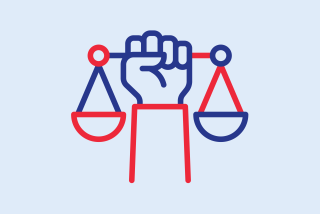Council OKs Tobacco, Alcohol Billboard Ban
- Share via
The Los Angeles City Council voted unanimously Wednesday to in effect eliminate existing tobacco and alcohol advertising from billboards and other signs, angering billboard and liquor interests, and drawing criticism from free speech advocates.
“Before us is a basic choice,” Councilman Michael Feuer, a strong backer of the measure, told an overflow crowd before the council passed the ordinance 13 to 0. “Are we going to put kids first or alcohol, tobacco and billboard companies first?”
The measure would ban alcohol or tobacco advertisements in public view within 1,000 feet of homes, schools, parks, playgrounds, churches, youth centers and entertainment centers--an area so vast that city planners estimated that it would affect 97% of the 2,777 billboards in the city.
If signed as expected by Mayor Richard Riordan, the measure will be among the most restrictive such ordinances in a major U.S. city.
In June, Los Angeles County passed a measure similar to the city’s proposed ordinance, although it is considered much weaker. The county’s measure prohibits billboards within 1,000 feet of places frequented by children, and in residential zones, something of a moot point in Los Angeles, where none are permitted in residential zones anyway.
By contrast, the city’s ordinance contains a key restriction that banishes such advertisement in a 1,000-foot radius around residential areas. This single component of the ordinance would affect 95% of Los Angeles’ billboards.
Similar ordinances targeting splashy outdoor cigarette and beer advertisements have been passed by cities around the country in recent years, including Baltimore, New York, Oakland and San Francisco, reflecting growing public concern over the effect of such advertising on children.
But even before the vote was taken Wednesday, opponents, including the national Distilled Spirits Council, vowed to challenge the measure in court, saying it represents an infringement of free speech, and other detractors said they will consider lawsuits.
“These ordinances are censorship, pure and simple,” said Rex Heinke, attorney for Eller Media Co., a billboard firm that is weighing a lawsuit.
ACLU Sees Possible Challenge
The American Civil Liberties Union opposed the restrictions as unconstitutional and “overbroad.”
“I think they [opponents] have a basis to challenge,” said ACLU staff attorney Peter Eliasberg after the vote. The council “should take the Constitution into account before making decisions about free speech.”
Supporters of such ordinances have cited research that purports to link exposure to advertisements with teenage drinking and smoking.
The laws have put billboard companies on the defensive and have spawned numerous legal challenges on constitutional grounds. The various billboard ordinances differ, which makes comparison difficult, but the city attorney’s office said most have been upheld.
Feuer argued that the measure is needed to protect children from the influence of advertisements for beer and cigarettes.
“To me, it’s worth defending a lawsuit if it means protecting our kids,” he said. “The bottom line for me is that deterring kids from illegal drinking and smoking is more important than the commercial speech of alcohol and tobacco companies.”
But there were only scant references made to the 1st Amendment during Wednesday’s hourlong council discussion of the ordinance.
The discussion drew a rare crowd that packed the council chambers downtown. Members of youth groups, minority advocacy groups and anti-substance abuse groups, such as Mothers Against Drunk Driving, spoke in favor of the ordinance. Grade-school children in the crowd waved signs: “Spare the children from tobacco companies’ greed,” read one.
With the exception of northwest San Fernando Valley Councilman Hal Bernson and Council President John Ferraro, who favored a slightly less restrictive version of the ordinance, council members voiced unqualified support for the measure. In the end, Bernson and Ferraro voted with the majority.
Among the most impassioned supporters were council members from South and East Los Angeles, who accused tobacco and alcohol advertising of targeting minority communities.
“These communities have enough problems as it is,” said City Councilman Nate Holden, of South-Central Los Angeles.
City Councilman Mike Hernandez, who was arrested on a cocaine charge earlier this year, added a personal note: “As someone going through a recovery program, there is no question in my mind that we have to do something to protect our children from abusing alcohol,” he said.
Sharon Siedorf Cardenas of the city attorney’s office said she “fully expects” that opponents will challenge the measure in court.
It remains unclear whether the ordinance will withstand a constitutional challenge, she said, although, “I think there is a better chance of it being upheld than not.”
Entering a Gray Area
The ordinance touches on a still-evolving area of the law, commercial speech, said USC law professor Michael H. Shapiro. Until 1976, such speech had no 1st Amendment protection, Shapiro said. Since then, courts have ruled that it has some protections, although less than political free speech protected by the Constitution.
However, more recent Supreme Court rulings have tended to increase protections for commercial speech, said Shapiro, who suggested that the city ordinance might be seen as “a ruse,” that is, an outright ban on such advertisements, disguised as a land-use restriction.
Even when the aim is to protect children, he said, the court has hesitated to back such bans on commercial speech.
“A lot of stuff is bad for kids out there, but you can’t stop it from getting around,” Shapiro said. “If you start eliminating every conceivable risk, you end up seriously restricting freedoms. You can’t dismantle the entire architecture of the 1st Amendment for that reason.”
When the final vote was taken, supporters burst into cheers.
Billboard companies, including Eller Media and Outdoor Systems Inc., had lobbied hard against the measure for months. Both companies observe a voluntary industry standard that prohibits alcohol and tobacco advertisements within 500 feet of schools, parks, churches, playgrounds and hospitals, and argued that this was sufficient.
However, seeing the writing on the wall, some companies have already cut back on alcohol and tobacco advertisements. Chris Massey, spokesman for Outdoor Systems, said alcohol and tobacco advertisements amount to only 10% to 20% of the firm’s business. The billboard industry in Los Angeles and elsewhere has been booming, with plenty of other advertisers to replace these, said Dash Stolarz, spokeswoman for Eller.
More to Read
Sign up for Essential California
The most important California stories and recommendations in your inbox every morning.
You may occasionally receive promotional content from the Los Angeles Times.













